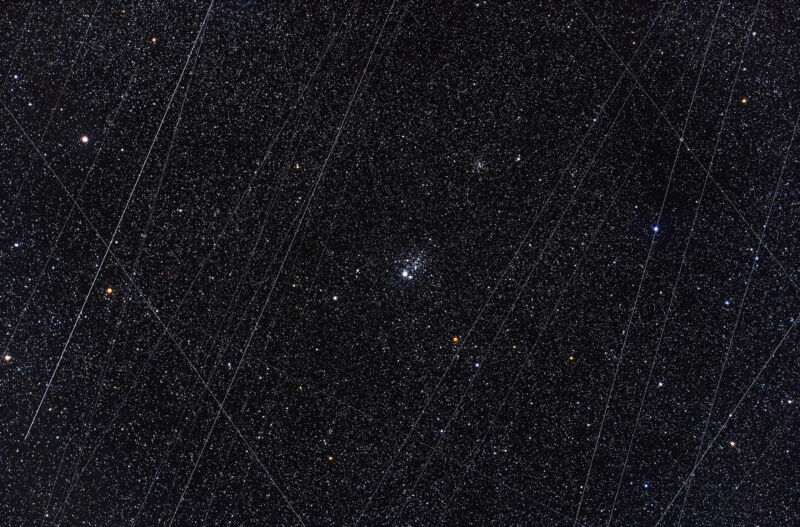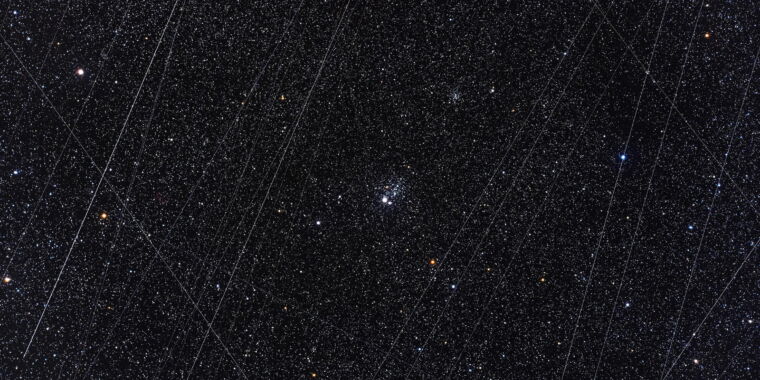Seeing stars —
Scientists search for solutions as Amazon plans to launch 3,200 satellites.
Ramin Skibba, wired.com
–

Alan Dyer/Getty Images
Amazon is set to launch two satellite prototypes for its Project Kuiper network, which will eventually number more than 3,200 orbiters. Project Kuiper could become a rival to SpaceX’s Starlink constellation, which is now nearly 4,800 strong. Amazon’s launch is planned for 2 pm Eastern time today, with a backup launch window tomorrow. This rapid growth of the satellite industry has come at a cost for astronomers and fans of the night sky, as two new studies and panels at an international astronomy conference stressed this week.
All spacecraft in low-Earth orbit reflect sunlight, and some glint enough to be visible to the naked eye—artificial constellations that compete with stellar ones. Satellites can cause problems for astronomers when they streak across images, interfere with radio observations, or make hard-earned data less scientifically useful. By one estimate, there could be some 100,000 satellites swarming the skies in the 2030s. While scientists are mainly concerned about this aggregate effect, some individual satellites are very bright indeed. A study published in the journal Nature this week shows that a prototype of AST SpaceMobile’s BlueBird swarm has become one of the brightest objects in the heavens. Another study documents how even deliberately darkened satellites are still twice as bright—if not more—than the limit astronomers have called for to minimize effects on space science.
Such concerns prompted a major conference this week, organized by the International Astronomical Union’s Centre for the Protection of the Dark and Quiet Sky from Satellite Constellation Interference, known as CPS. It’s being held in the Canary Islands, where there are several observatories. It’s the first in-person meeting of its kind, bringing together scores of astronomers, as well as satellite industry representatives, advocates of Indigenous and environmental perspectives, and policy experts.
“We’re on the cusp of a new era with a crowded, large zoo of satellites. Having a bunch of bright satellites in the sky will be very disruptive to astronomy,” says Aparna Venkatesan, an astrophysicist at the University of San Francisco who spoke at the meeting about environmental and cultural views of the night sky. She coauthored an earlier study about how satellite proliferation boosts the risks of collisions in low-Earth orbit and increases the amount of space junk. The CPS meeting was delayed multiple times because of COVID and a volcano eruption, so it’s long overdue, Venkatesan says. “But in a way, waiting has been a gift, because the astronomers and modelers and data takers have been able to organize.”
Enlarge / The United Launch Alliance Atlas V rocket is transported from the Vertical Integration Facility to Space Launch Complex-41 at Cape Canaveral, Florida, in preparation to launch Amazon’s Project Kuiper Protoflight mission.
United Launch Alliance
Astronomers are concerned that bright satellites can photobomb images and interfere with radio receivers, degrading astronomical data. A team working on the Vera Rubin Observatory in the Chilean Andes, which will become one of the most powerful telescopes on Earth when it opens next year, has proposed a brightness limit of apparent magnitude 7. (Apparent magnitudes describe how bright something appears on Earth, not its absolute brightness. A distant galaxy can have a fainter magnitude than a nearby star or a much closer satellite.) But most members of satellite constellations glow much brighter than that, at least part of the time.
Satellite networks also create a diffuse light in the night sky, even from orbiters that aren’t individually visible. That light will only brighten if satellites collide, creating reflective bits of flying junk that can’t be masked in images. Starlink satellites have been involved in many near misses, including flying near China’s Tiangong space station.
While ground telescopes are the most impaired, a few space telescopes, especially Hubble, have been affected too. Since Hubble orbits slightly below some networks of satellites, a small but increasing percentage of its images have streaks in them.
The conference organizers emphasize that astronomers generally don’t oppose satellite constellations, which can deliver broadband access, navigation, and other important services. “The potential benefits to humanity are great, but so are the associated concerns. Creative solutions and technological innovation are needed to confront and solve these problems,” the conference’s website states. But the attendees are struggling to address interference thanks to satellites’ growing numbers. “From the astronomy point of view, there’s nothing we can do to stop this. It’s time to mitigate the effects and reduce the impacts,” says Mike Peel, an astronomer at the Instituto de Astrofísica de Canarias, who co-leads the CPS’s group focused on adapting observation strategies.
…. to be continued
Read the Original Article
Copyright for syndicated content belongs to the linked Source : Ars Technica – https://arstechnica.com/?p=1974159
